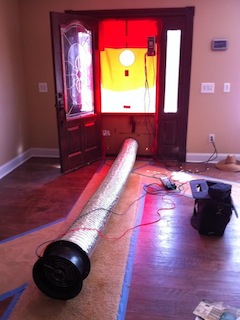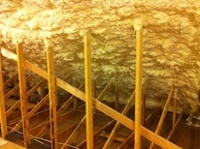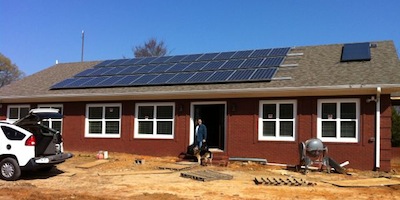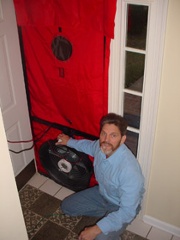A Net Zero Energy Home in Rural Tennessee

On my thousand-mile quality assurance road trip last week, I visited a house that was designed to produce more energy than it uses, making it a net zero energy home. You can take any house all the way to net zero just by giving it enough on-site power production (photovoltaics, wind, hydropower…), but that’s not the most effective way to achieve the goal of net zero energy use. First, you want to make the house really efficient, and that’s what these folks did.
If you’re a home energy pro, the photo at left may look a little odd to you (unless you work on Passive House or similar super-efficient projects). That’s my setup when I was testing the house for air leakage. Yes, it’s a Blower Door test that I was running with a Duct Blaster fan. Even better, I was running the fan with the smallest ring (Ring 3). Because the house was so tight, I needed to use equipment that would give me better resolution than the larger Blower Door fan.
This house was really, really tight. The air leakage was <200 cfm50, which translated to about 0.5 ACH50. For reference, the Georgia energy code requires all new homes to test at 7 ACH50 or less. The Passive House standard for air leakage is 0.6 ACH50.
Wondering how they got the house that tight? They took a number of measures, all of them designed to eliminate the common sources of air leakage:
- Simple design – only 4 corners and a single gable roof
- Slab foundation
- Insulating Concrete Form (ICF) walls

- Spray foam insulation on the roofline
They did a great job with the rest of the energy efficiency details, too. It’s becoming the norm these days, but I’ll mention anyway that they used double pane, low-e windows. The ceiling fans, lights, and appliances all were super efficient as well. They also installed a ground source heat pump with all ducts in the conditioned attic. That means there was no duct leakage to the outside. Of course, they installed a solar water heater, too, which you can see to the right of the PV system in the photo below.

Once they made the house as efficient as possible, the amount of on-site power production they needed to get to net zero was smaller. The photovoltaic system on the south-facing roof ended up at about 8 kilowatts, which actually should put them below net zero. That means that the power company will be sending them money each year.
So, how do you build a net zero energy home? The first thing to do is to have someone like Jack Cowan on your team. Jack is a HERS rater in the Memphis, Tennessee area, and he started his rating company, Cowanhouse, over a decade ago. The house described in this article is going to be his nephew’s home, and Jack has helped with the design and construction, as well as being the rater on the project. He’s done a number of renewable energy projects, too, and was able to do the modeling and specifications for the PV system here.
home? The first thing to do is to have someone like Jack Cowan on your team. Jack is a HERS rater in the Memphis, Tennessee area, and he started his rating company, Cowanhouse, over a decade ago. The house described in this article is going to be his nephew’s home, and Jack has helped with the design and construction, as well as being the rater on the project. He’s done a number of renewable energy projects, too, and was able to do the modeling and specifications for the PV system here.
Meeting great people doing amazing work is one of the reasons I love what I do so much.
This Post Has 9 Comments
Comments are closed.

Ahhh. The way houses are
Ahhh. The way houses are supposed to be.
That is a really nice job. I
That is a really nice job. I am not sure the geo is worth it, and I want to know about ventilation. Lastly — when there are a year’s worth of utility bills it would be nice to do a follow up.
A true professional. Once
A true professional. Once again an amazing project. Congrats Jack and Jeff.
Very impressive! It’s nice to
Very impressive! It’s nice to see people being successful creating net zero homes. I’m also interested to see what the actual usage ends up being and how the ventilation is managed. Thanks for sharing!
Chris: It
Chris: It’s truly a high performance home, that’s for sure.
John: I don’t think I’d have chosen a ground source heat pump either. I forgot to mention it above, but they put in a Broan Fresh Air System (combined HEPA filter and ERV) for ventilation. I do plan to do some follow up on this house and write about it when they have some energy bill/production data.
Josh: Yep!
Nichole: See my response to John above.
It would be nice to know what
It would be nice to know what making your home this energy efficient costs.
Thanks for the article
Thanks for the article recognizing Jack’s contribution to this house making it such an energy efficient, high performance home. On a side note, this is Jack’s 2nd Net ZEH. The other home is of lumber construction, with a smaller PV system – it has been occupied and on the National Solar Tour for 3 yrs. During this time, the owner did not have to pay a single utility bill and has received a check from the local utility at the end of each year for over $500. Jack has a good handle on designing and building ZEHs.
On a net zero energy home is
On a net zero energy home is there still the “meter surcharge” that everybody else has to pay/ For us our bill is $13/mo before you turn on a single light switch.
“Once they made the
“Once they made the house as efficient as possible, the amount of on-site power production they needed to get to net zero was smaller. The photovoltaic system on the south-facing roof ended up at about 8 kilowatts, which actually should put them below net zero. That means that the power company will be sending them money each year.”